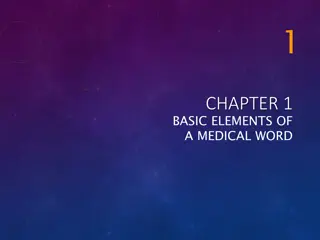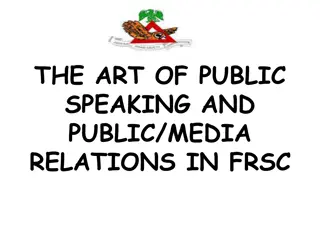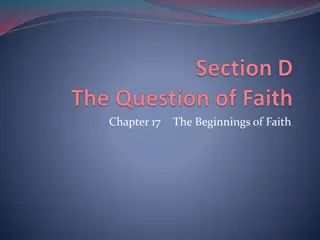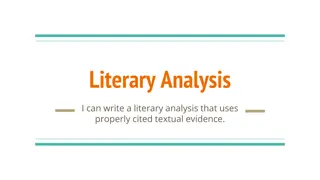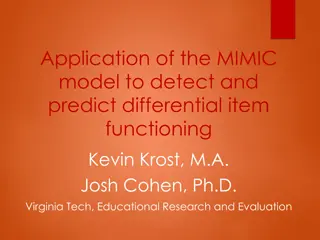Understanding Vulnerability: Meaning, Types, and Factors affecting Vulnerability
This article explores the concept of vulnerability, including its meaning, types (physical and social), and factors that contribute to vulnerability. It discusses the impact of hazardous events on communities, infrastructure, and the environment, and highlights the importance of awareness and prepar
26 views • 31 slides
Understanding Non-literal Meaning: Idioms, Metaphors, and Metonymy
The unpredictable world of non-literal meaning through idiomatic expressions, metaphors, and metonymy. Discover how these concepts shape language and thought.
3 views • 37 slides
Exploring the Two Dimensions of Meaning: Similarity and Contiguity in Language and Literature
This content delves into the dimensions of meaning, focusing on similarity and contiguity, as explored in language and literature. It discusses the significance of Saussure's paradigm and syntagm, Jakobson's theories on similarity and contiguity in discourse, and the impact of brain damage on langua
0 views • 66 slides
Exploring Economics in Everyday Life with Jack Meaning
Engage students in understanding the impact of economics through activities centered around the book "Can't We Just Print More Money?" by Jack Meaning. From discussing sandwiches as an analogy for economic concepts to exploring career paths and financial literacy, this lesson plan aims to enhance st
0 views • 18 slides
Understanding Semasiology: The Study of Word Meaning
Semasiology is a branch of linguistics focused on the meaning of words. It delves into various aspects of lexical meaning, semantic development, polysemy, and semantic structure. Through exploring types of word meanings and semantic changes, semasiology helps us comprehend the intricate nuances of l
4 views • 19 slides
Understanding Translation: Key Concepts and Definitions
Translation involves transferring written text from one language to another, while interpreting deals with oral communication. Etymologically, the term "translation" comes from Latin meaning "to carry over." It is a process of replacing an original text with another in a different language. Translat
11 views • 76 slides
Analyzing Gender-Based Double Standard in Taylor Swift's "The Man
Analyzing Taylor Swift's song "The Man" through a semantic approach, exploring the meaning using Leech's seven types of meaning theory. The study connects the lyrics and music video to real-life experiences, focusing on gender-based double standards prevalent in society.
3 views • 12 slides
Understanding Medical Word Elements: Roots, Combining Forms, Suffixes, and Prefixes
Medical terminology uses word elements like roots, combining forms, suffixes, and prefixes. Word roots provide the main meaning, combining forms connect elements, suffixes modify word meaning, and prefixes are placed at the beginning of words. Examples illustrate how these elements are used in medic
6 views • 13 slides
Understanding Translation: The Art of Conveying Meaning Across Languages
Translation is the creative act of transferring thoughts and ideas from one language to another, preserving meaning and style. It involves finding the closest natural equivalent in the target language while considering cultural contexts and linguistic nuances. Various methods and goals impact the fi
8 views • 25 slides
Understanding Semasiology: The Study of Meaning in Language
Semasiology, a branch of lexicology, focuses on the study of meaning in language through different approaches such as the referent approach and functional approach. The referent approach links the sound form with the concept denoted by the word, while the functional approach emphasizes the relations
2 views • 15 slides
Understanding Grice's Logic of Conversation in English Language
Grice's Logic of Conversation delves into the principles and rules that govern successful communication, even when meaning isn't explicitly stated. Through co-operation and adherence to Gricean maxims, conversations are able to convey meaning effectively, showcasing the intricacies of human interact
0 views • 34 slides
Understanding Connotative Meaning and Translation Issues
Exploring the complexities of connotative meaning within texts, this article discusses the various types of connotative meanings and the challenges they pose for translation. It delves into attitudinal, associative, and affective meanings, emphasizing the importance of recognizing and preserving the
1 views • 17 slides
Understanding Semantic Features in Language Study
Studying basic conceptual meaning is crucial in language analysis to explain the oddness in sentences like "The hamburger ate the boy." Semantic roles and thematic roles help identify the roles of entities in a sentence, such as agents and themes. By analyzing the components of conceptual meaning, w
1 views • 12 slides
Understanding Semantics: The Study of Meaning in Linguistics
Semantics is the scientific study of meaning in language, delving into questions about definitions, ideas, objects, relations between meanings, and how meanings interact with syntactic rules. Exploring the vagueness of the term "meaning," semanticists explore sense, reference, denotation, and connot
2 views • 19 slides
Mastering the Art of Public Speaking and Public Relations in FRSC
The Federal Road Safety Corps (FRSC) aims to address road traffic crashes through attitudinal change and safety consciousness. This lecture focuses on teaching officers the techniques of public speaking, emphasizing qualities of a good speech and speaker. Participants will learn to deliver impactful
0 views • 27 slides
Understanding Communication Barriers: Insights from Dr. Nadeem Khan
Communication barriers can hinder the effectiveness of communication processes. Psychological barriers, physiological barriers, physical barriers, and attitudinal barriers all play a role in how messages are received and understood. Recognizing and addressing these barriers is essential for improvin
0 views • 12 slides
An Exploration of Linguistic Meaning: Semantics and Pragmatics
Delve into the realm of linguistic meaning through the lenses of semantics and pragmatics. Explore how words and phrases carry literal meanings, while language usage in social contexts creates both literal and nonliteral meanings. Uncover the intricate interplay between semantics, concerned with the
6 views • 70 slides
Exploring Connotative Meaning and Translation Issues in Language
Delve into the nuances of connotative meaning through allusive, collocation, and reflected meanings. Discover how translation challenges arise due to cultural nuances and connotations, as exemplified by various expressions and word associations. Explore the significance of appropriate collocations i
0 views • 16 slides
Understanding Evaluation and Ideology in Translation
Evaluation plays a crucial role in the study of translation, influencing both meaning and value in communication. This evaluation is reflected through language elements like accentuation, deletion, and substitution. Appraisal, stance, and evaluation are key terms in linguistic analysis that focus on
2 views • 22 slides
Overcoming Attitudinal Barriers for Students with Disabilities in Higher Education
Achieving environmental access in higher education environments for students with disabilities requires abolishing attitudinal barriers first. Positive faculty attitudes have been shown to enhance academic success for these students, combating stigma and societal disadvantages associated with disabi
1 views • 13 slides
Meaning and Meaning-making in Big Q Qualitative Research
Qualitative research explores different understandings of meaning and meaning-making, providing researchers with tools, techniques, and values. Big Q qualitative research focuses on the active role of words in creating meaning beyond reflecting experiences. This lecture series delves into the founda
1 views • 20 slides
Understanding Levels of Meaning in Language
Explore the concept of denotation versus connotation and delve into the various types of connotative meanings including attitudinal, associative, affective, and allusive meanings presented by Ayat Amer AbdI.-Sattar. Discover how words can carry multiple layers of meaning beyond their literal interpr
0 views • 16 slides
Understanding Society: Wealth and Assets Survey Research
The Wealth and Assets Survey (WAS) conducted by Oliver Tatum and Angie Osborn at the Understanding Society Research Conference in 2013 focuses on longitudinal issues, experiment design, research findings, and future plans related to the survey. The WAS background includes collecting data on personal
3 views • 28 slides
Understanding Denotative Meaning and Translation Issues
Denotative meaning in translation poses challenges due to the elastic and indeterminate nature of meaning, especially in dealing with the cognitive or literal sense of words. Polysemy, homonymy, and synonymy contribute to complexities in determining precise denotative meanings. The rigidity and flex
0 views • 40 slides
Mindfulness Practices for Adolescents: Learn to Cultivate Awareness
Explore mindfulness practices such as MindUP and Learn to Breathe for adolescents to enhance emotion regulation, attention, and performance. Understand the core meditations, attitudinal foundations, and the benefits of mindfulness in daily life. Dive into resources and curriculums aimed at cultivati
0 views • 32 slides
Exploring the Meaning of Life and Purpose Through Faith and Reflection
Humans are inherently curious, constantly seeking answers to questions about life's meaning and purpose. The journey involves questioning, searching for meaning in various aspects of life, exploring religious beliefs, and engaging in reflective practices.
0 views • 10 slides
Introduction to Meaning in Language: Semantics & Pragmatics
Meaning in language is explored in this introductory lecture, covering aspects such as communication, semiotics, linguistic channels, and approaches to studying meaning. The process of encoding messages, signal transmission, noise interference, and decoding are discussed within the context of commun
0 views • 19 slides
Exploring Fictional Speech and Phonostylistics in Literature
Delve into the realm of fictional speech and phonostylistics within literature, examining the representation of speech versus real speech, the encoding of spatial, social, and attitudinal markers, and the significance of fictional speech in creating immersive narratives. Discover how authors navigat
0 views • 30 slides
Transforming India's Digital Payment Landscape: Interim Report and Recommendations
This interim report to Honorable Prime Minister Narendra Modi and Chief Minister Nara Chandrababu Naidu highlights the progress and challenges in transitioning India towards a digital payments ecosystem. Recommendations include measures to advance digital payment systems, promote financial inclusion
0 views • 10 slides
Dive into Literary Analysis: Understanding the Depths of Textual Meaning
Literary analysis involves dissecting literature to uncover the significance of its parts and how they contribute to the overall meaning. By examining rhetoric and story elements, and exploring the significance and meaning behind the text, readers can gain a deeper understanding of the author's mess
0 views • 10 slides
Understanding Meaning in Work for Millennials: A Heuristic Study
This study explores the experience of meaning in work for millennials, considering its impact on organizational commitment, change, vision-championing, and leadership. It aims to contribute to the existing knowledge base by examining how millennials perceive and create meaning in their work, using q
0 views • 14 slides
Understanding Philosophy: The Search for Wisdom and Truth
The term "philosophy" originates from Greek words meaning "love of wisdom." True philosophy involves seeking meaning and connections among ideas, transcending mere curiosity. Various definitions emphasize philosophy as the foundation of all arts, the science of sciences, and the pursuit of eternal k
0 views • 6 slides
Exploring Semantics: Meaning of Words and Concepts
Semantics is the study of the meaning of words, ranging from their basic literal components to their associative connotations. This branch of linguistics focuses on objective meaning shared by all rather than subjective interpretations. Concepts like conceptual and associative meanings are explained
0 views • 22 slides
Understanding Semantics: Exploring Types and Dimensions of Meaning
Explore the complexities of semantics by delving into the types and dimensions of meaning. From descriptive to non-descriptive meaning, learn how the normality profile of linguistic items contributes to their overall meaning. Distinguish between semantic and grammatical anomalies and discover the nu
0 views • 32 slides
Understanding Semantics: Meaning, Reference, and Sense
Explore the intricate world of semantics through an analysis of meaning, reference, denotation, connotation, and the classification of meaning by G. Leech. Delve into the concepts of conceptual and associative meanings, and understand the importance of sense in expressions. Learn how connotations pl
0 views • 32 slides
Understanding the Ontario Accessibility for Ontarians with Disabilities Act (AODA)
The Accessibility for Ontarians with Disabilities Act (AODA) was enacted in 2005 with a goal to make Ontario accessible by 2025. It sets out mandatory standards in areas like customer service, employment, information, transportation, and public spaces. Disabilities can vary in severity and type, aff
0 views • 37 slides
Detecting and Predicting Differential Item Functioning Using the MIMIC Model
Explore how the Multiple Indicators Multiple Causes (MIMIC) model can be applied to detect and predict potential biases in assessments, particularly between genders. Research questions include investigating attitudinal factors that may influence differential item functioning. The model incorporates
0 views • 13 slides
Nationwide Undergraduates' Interest in Earth Careers & Motivation
This study explores undergraduates' interest in earth-related careers and motivation to address environmental challenges. The research, supported by the NSF, utilized an Attitudinal Instrument survey to gather data on career interests, concerns about environmental issues, and demographic information
0 views • 25 slides
Understanding Semantics, Lexical, and Grammatical Meaning
Exploring the nuances of semantics, lexical meaning, and grammatical meaning, this content delves into the distinctions between them, the role of lexemes, and the complexities associated with words. It discusses the various kinds of meanings expressed at the lexical and grammatical levels, including
1 views • 37 slides
Introduction to Semantics and Pragmatics: Understanding Meaning in Language
This lecture delves into the fundamental concepts of semantics and pragmatics, exploring the distinction between extension and intension in language meaning. It discusses the relationships between words, the world, and other linguistic elements, emphasizing the importance of sense, denotation, and r
0 views • 13 slides







